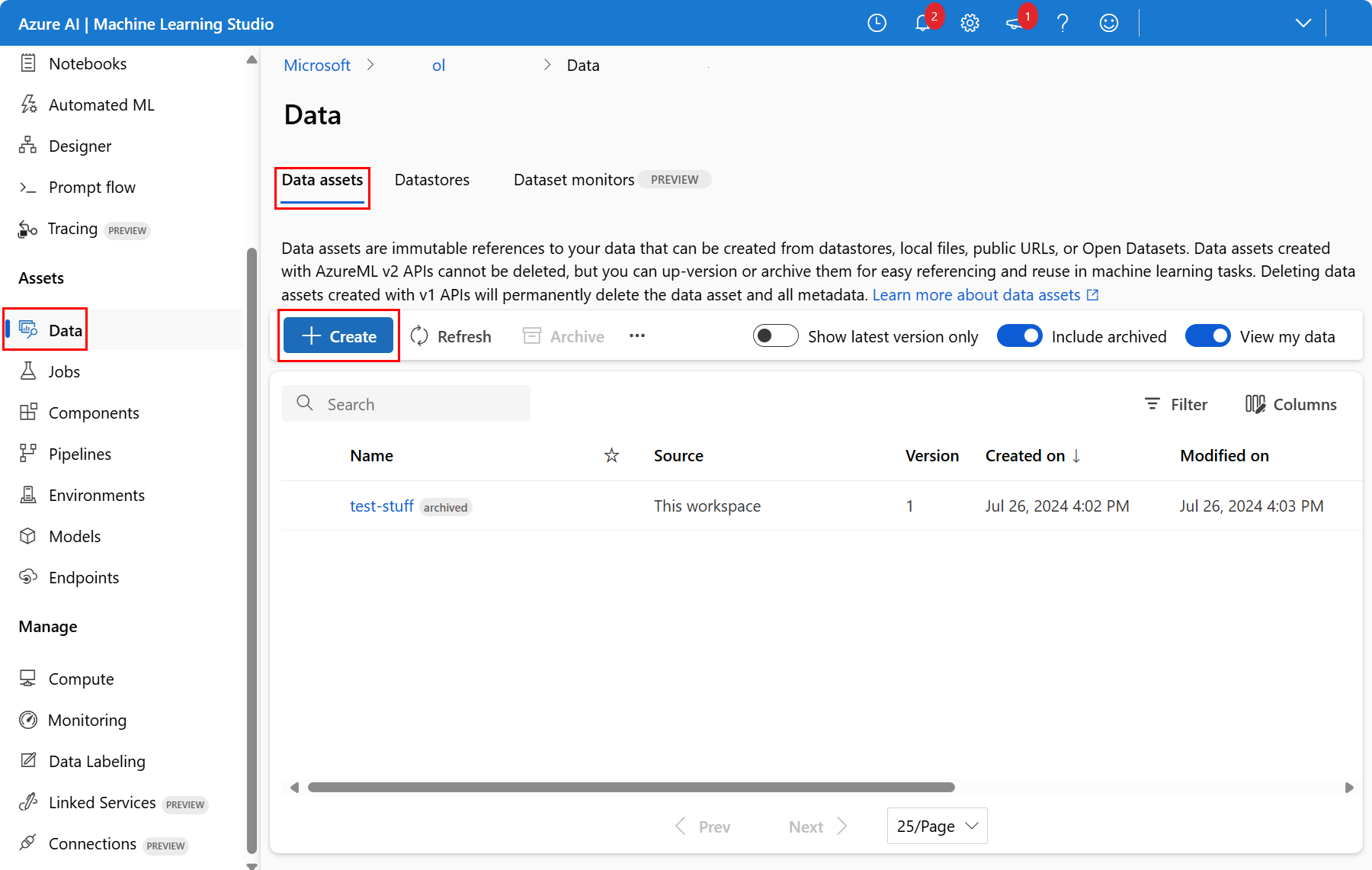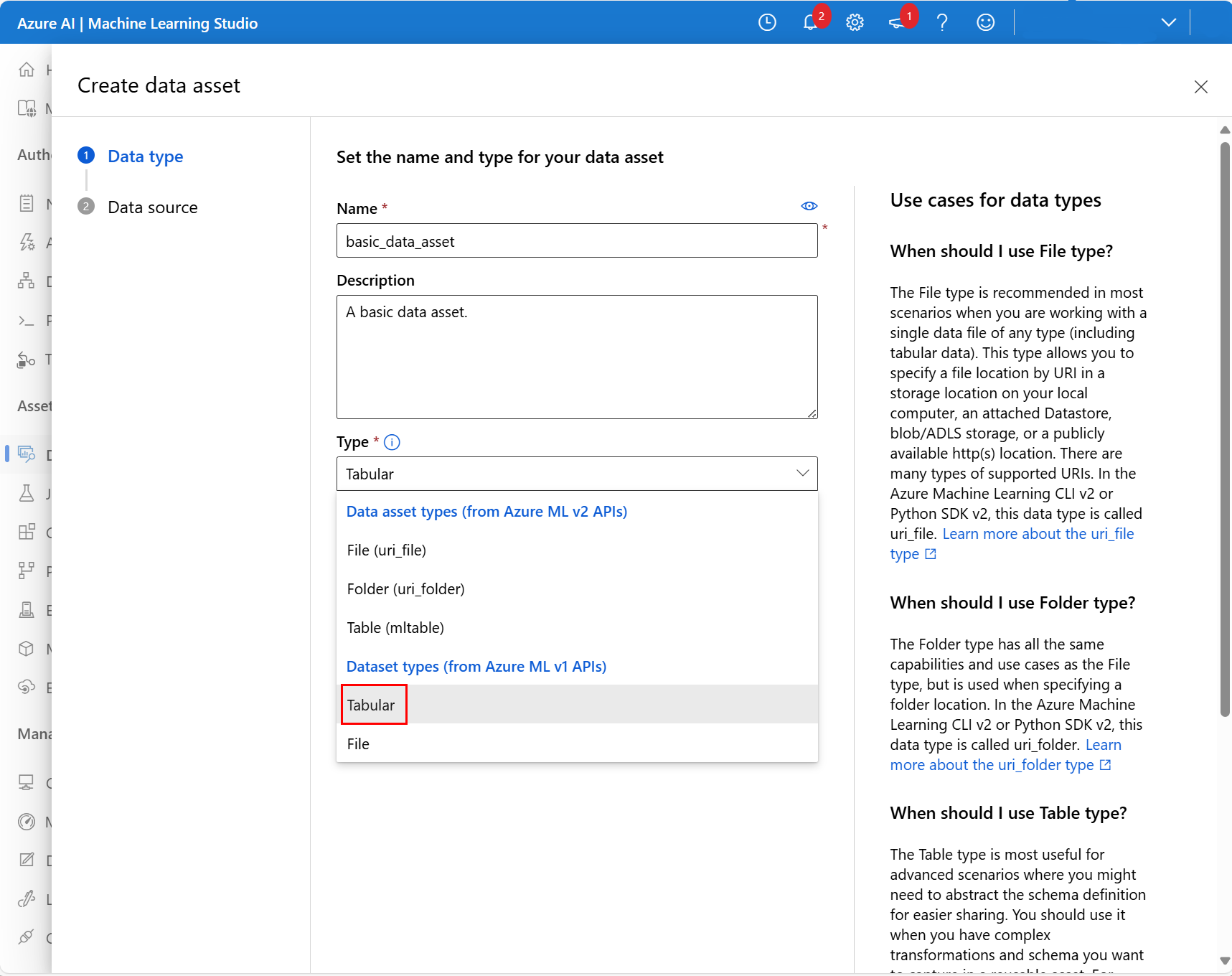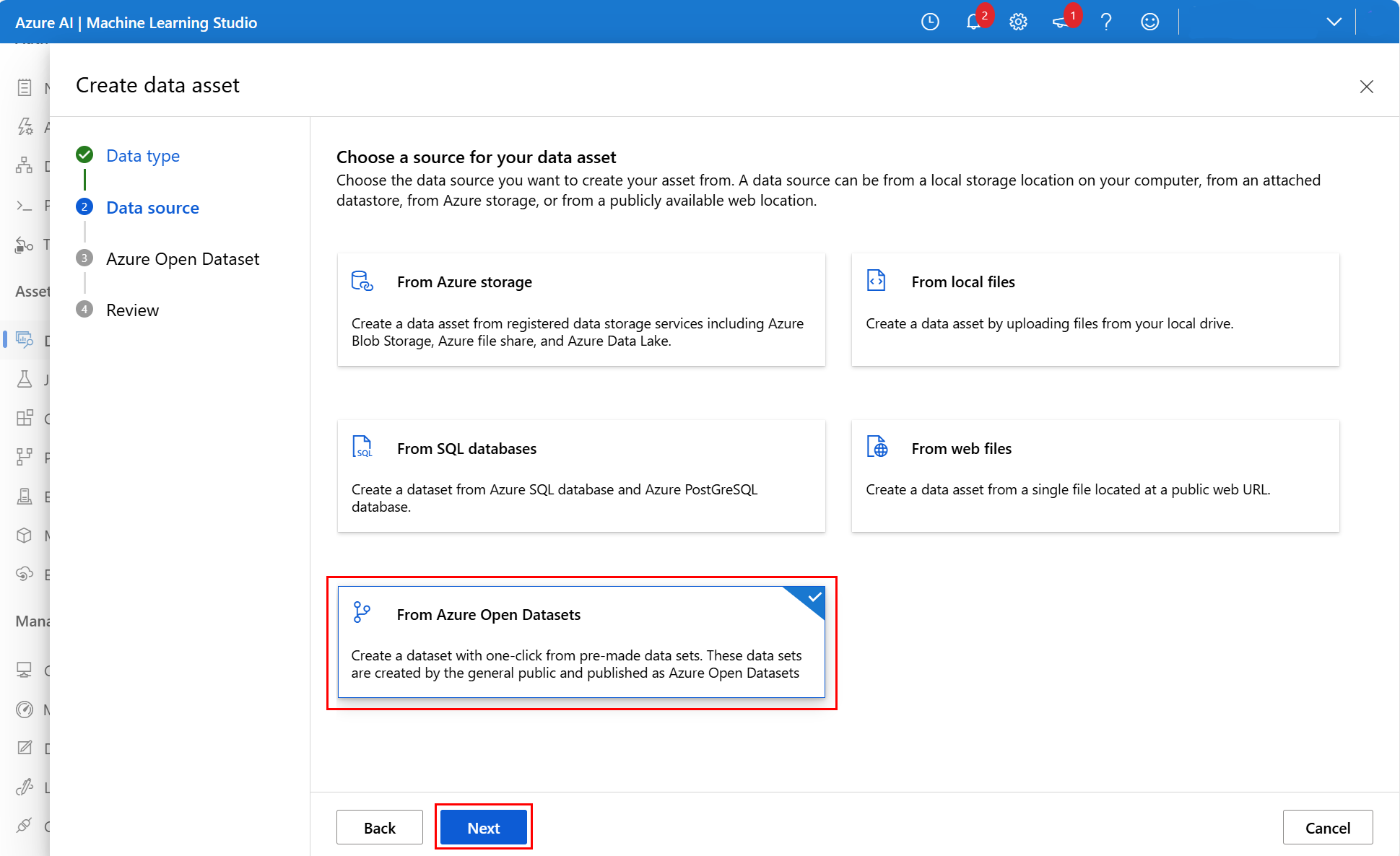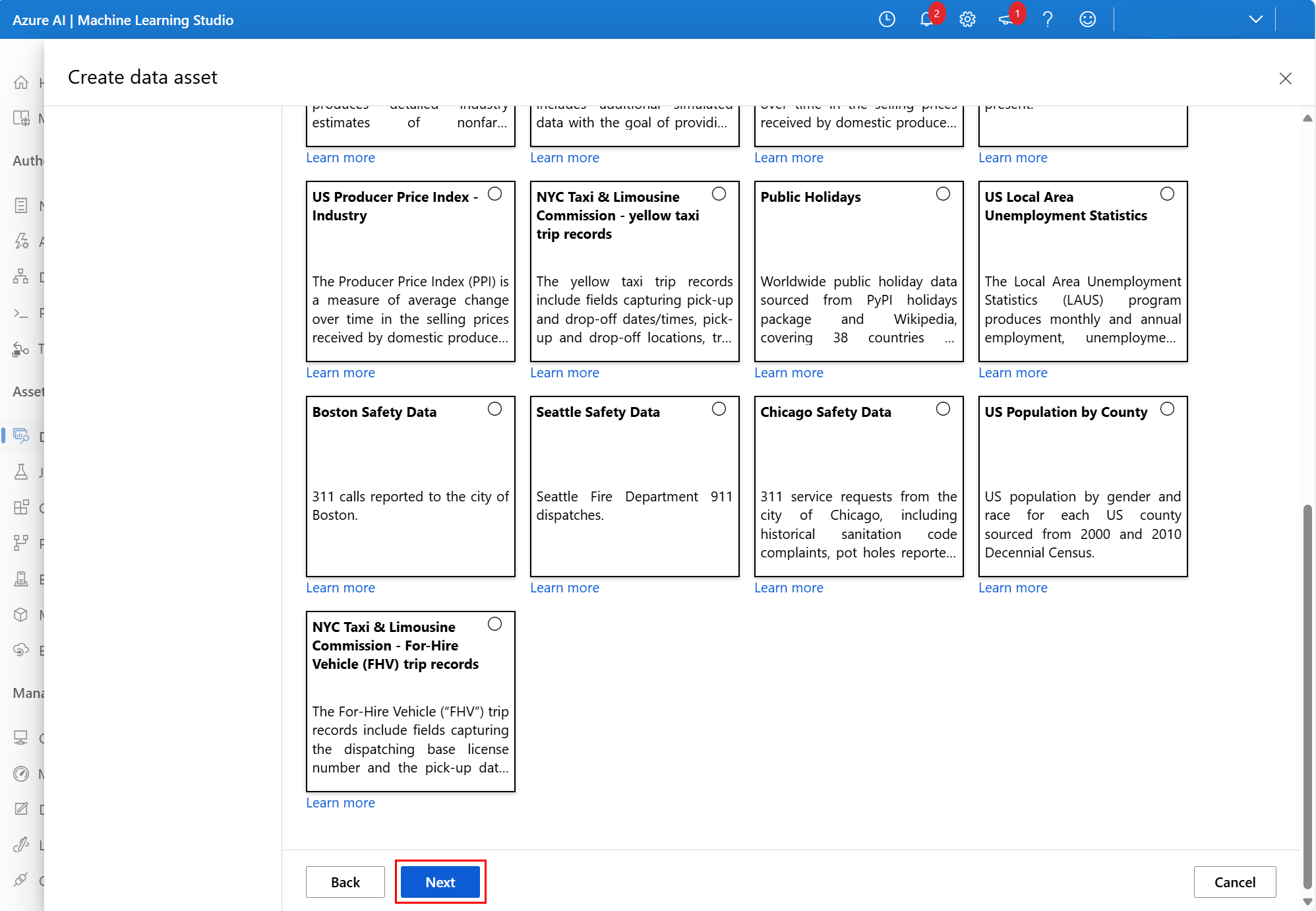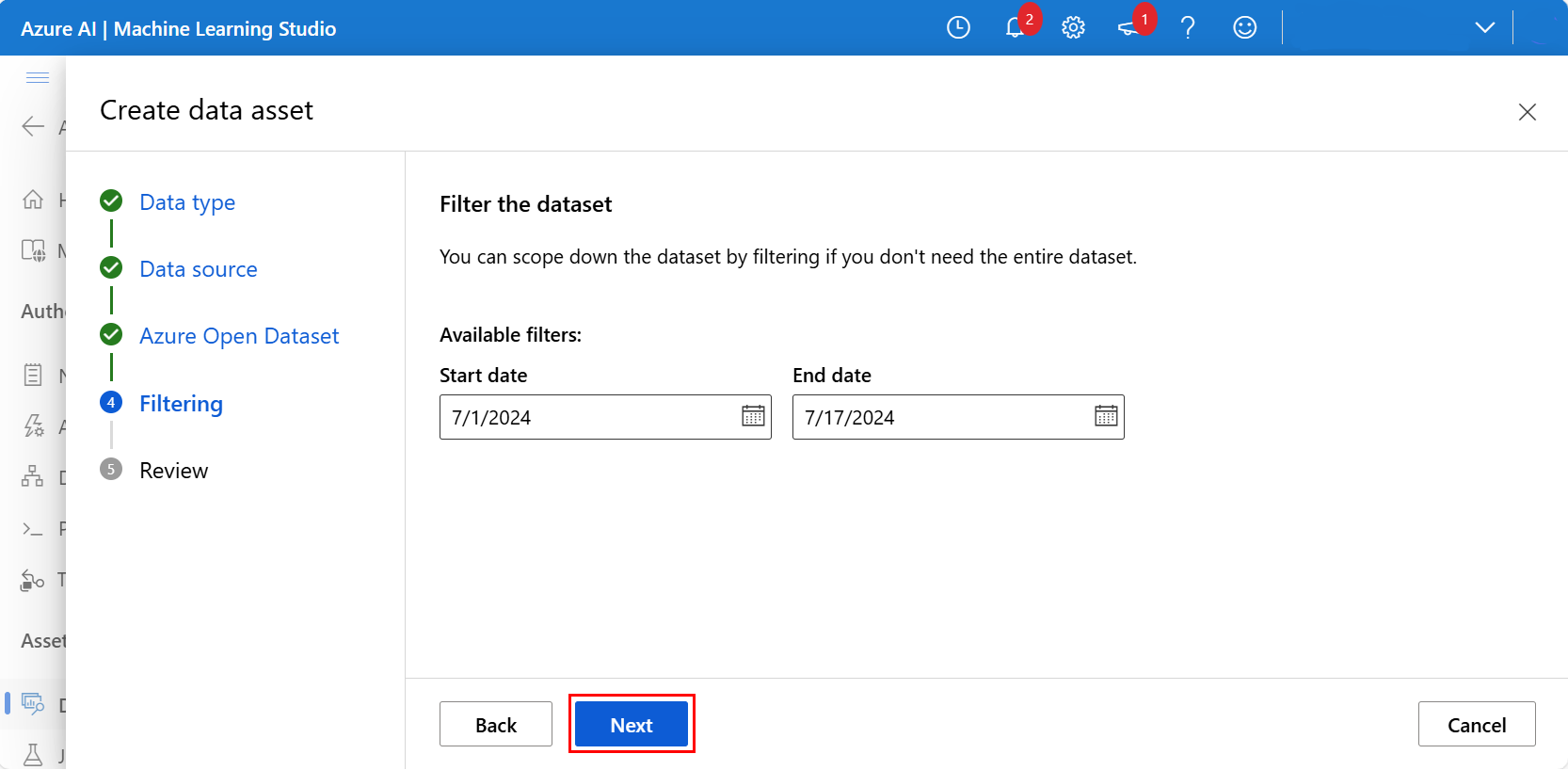Create Azure Machine Learning datasets from Azure Open Datasets
In this article, you learn how to bring curated enrichment data into your local or remote machine learning experiments, with Azure Machine Learning datasets and Azure Open Datasets.
With an Azure Machine Learning dataset, you create a reference to the data source location, along with a copy of its metadata. Because datasets are lazily evaluated, and because the data remains in its existing location, you
- Don't risk unintentionally changes to your original data sources
- Incur no extra storage cost
- Improve ML workflow performance speeds
For more information about where datasets fit in the overall Azure Machine Learning data access workflow, visit the Securely access data article.
Azure Open Datasets are curated public datasets that add scenario-specific features to enrich your predictive solutions and improve the accuracy of those solutions. Visit the Open Datasets catalog resource for public-domain data that can help you train machine learning models - for example:
- Health and genomics
- Labor and economics
- Population and safety
- Supplemental and common datasets
- Transportation
Open Datasets are hosted in the cloud on Microsoft Azure. Both Azure Machine Learning Python SDK and Azure Machine Learning studio include them.
Prerequisites
You need:
An Azure subscription. If you don't have one, create a free account before you begin. Try the free or paid version of Azure Machine Learning.
The Azure Machine Learning SDK for Python installed, which includes the
azureml-datasetspackage.- Create an Azure Machine Learning compute instance - a fully configured and managed development environment that includes integrated notebooks and the SDK already installed.
OR
- Work in your own Python environment, and install the SDK yourself with these instructions.
Note
Some dataset classes have dependencies on the azureml-dataprep package. This package is only compatible with 64-bit Python. For Linux users, these classes are supported only on these Linux distributions:
- Debian (8, 9)
- Fedora (27, 28)
- Red Hat Enterprise Linux (7, 8)
- Ubuntu (14.04, 16.04, 18.04)
Create datasets with the SDK
To create Azure Machine Learning datasets via Azure Open Datasets classes, in the Python SDK, make sure you installed the package with pip install azureml-opendatasets. In the SDK, the class of each discrete data set represents that class, and certain classes are available as either an Azure Machine Learning FileDataset datatype, an Azure Machine Learning TabularDataset datatype, or both. Visit the reference documentation for a full list of opendatasets classes.
You can retrieve certain opendatasets classes as either TabularDataset or FileDataset resources. You can then manipulate and/or download the files directly. Other classes can retrieve dataset only with use of the get_tabular_dataset() or get_file_dataset() functions from the Datasetclass in the Python SDK.
This code shows that the MNIST opendatasets class can return either a TabularDataset or FileDataset:
from azureml.core import Dataset
from azureml.opendatasets import MNIST
# MNIST class can return either TabularDataset or FileDataset
tabular_dataset = MNIST.get_tabular_dataset()
file_dataset = MNIST.get_file_dataset()
In this example, the Diabetes opendatasets class is only available as a TabularDataset. This requires the use of get_tabular_dataset().
from azureml.opendatasets import Diabetes
from azureml.core import Dataset
# Diabetes class can return ONLY TabularDataset and must be called from the static function
diabetes_tabular = Diabetes.get_tabular_dataset()
Register datasets
Register an Azure Machine Learning dataset with your workspace, so you can share the dataset with others and reuse it across experiments in your workspace. When you register an Azure Machine Learning dataset created from Open Datasets, no data is immediately downloaded, but the data becomes accessible later (during training, for example) when requested from a central storage location.
To register your datasets with a workspace, use the register() method.
titanic_ds = titanic_ds.register(workspace=workspace,
name='titanic_ds',
description='titanic training data')
Create datasets with the studio
You can also create Azure Machine Learning datasets from Azure Open Datasets with Azure Machine Learning studio. This consolidated web interface includes machine learning tools to perform data science scenarios for data science practitioners of all skill levels.
Note
Datasets created through Azure Machine Learning studio are automatically registered to the workspace.
In your workspace, select the Data in the left nav. At the Data assets tab, select Create, as show in this screenshot:
At the next screen, add a name and an optional description for the new data asset. Then, select Tabular in the Type dropdown, as shown in this screenshot:
At the next screen, select From Azure Open Datasets, and then select Next, as shown in this screenshot:
At the next screen, select an available Azure Open Dataset. In this screenshot, we selected the San Francisco Safety Data Dataset:
Scroll down if necessary, and select Next, as shown in this screenshot:
Optionally, filter the data with the available filters, appropriate for the chosen dataset. For the San Francisco Safety Data dataset, we set the filtered date range between a start date of July 1, 2024 and July 17, 2024. Select Next, as shown in this screenshot:
At the next screen, review the settings for the new data asset, and make any necessary changes. When it seems good, select Create as shown in this screenshot:
For more information about the field descriptions and date ranges for the San Francisco Safety Data dataset, visit the San Francisco Safety Data resource. For more information about the other datasets, visit the Azure Open Datasets Catalog resource.
The dataset is now available in your workspace under Datasets. You can use it in the same way as the other datasets you created.
Access datasets for your experiments
Use your datasets in your machine learning experiments for training ML models. For more information, visit Learn more about how to train with datasets.
Example notebooks
For examples and demonstrations of Open Datasets functionality, review these sample notebooks.
